13 minutes
XCTF REVERSE novice_writeup
XCTF-REVERSE-新手区 writeup
来XCTF平台,做做Re练练手

XCTF平台有十道题目:

十道题目应该是涵盖了逆向方向的主要内容,带着好奇心去探索逆向的世界吧
0x0 insanity
往往第一道题目都不是很难,下载附件,看看是个什么东西。
文件没有扩展名,可能是个ELF文件,走个流程
首先查一下壳
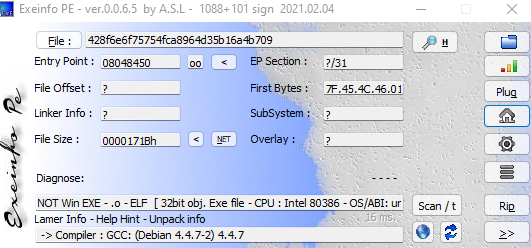
果然是ELF格式的文件,不过不是x64格式的ELF文件
使用IDA pro打开文件,查看主函数的反编译代码
int __cdecl main(int argc, const char **argv, const char **envp)
{
unsigned int v3; // eax
unsigned int v4; // eax
puts("Reticulating splines, please wait..");
sleep(5u);
v3 = time(0);
srand(v3);
v4 = rand();
puts((&strs)[v4 % 0xA]);
return 0;
}
跟进strs的数据

继续跟进strs的数据

get到了flag
9447{This_is_a_flag}
0x1 python-trade
看题目应该是一个Python的逆向题目
文件是一个pyc文件应该是Python的逆向文件,可以使用Python的反编译工具进行反编译
可以使用 uncompyle 进行反编译:
# uncompyle6 version 3.7.4
# Python bytecode 2.7 (62211)
# Decompiled from: Python 3.8.8 (default, Apr 13 2021, 15:08:03) [MSC v.1916 64 bit (AMD64)]
# Embedded file name: 1.py
# Compiled at: 2017-06-03 10:20:43
import base64
def encode(message):
s = ''
for i in message:
x = ord(i) ^ 32
x = x + 16
s += chr(x)
return base64.b64encode(s)
correct = 'XlNkVmtUI1MgXWBZXCFeKY+AaXNt'
flag = ''
print 'Input flag:'
flag = raw_input()
if encode(flag) == correct:
print 'correct'
else:
print 'wrong'
# okay decompiling .\test.pyc
应该是需要逆这个加密算法的进行求解,密码手的老本行了,写个求解脚本:
import base64
def Redecode(cipher):
message = ''
cipher = base64.b64decode(cipher).decode()
for i in cipher:
x = ord(i) - 16
x = x ^ 32
message += chr(x)
return message
cipher = 'XlNkVmtUI1MgXWBZXCFeKY+AaXNt'
flag = Redecode(cipher)
print(flag)
在python2环境下运行脚本,就能得到flag了:
nctf{d3c0mpil1n9_PyC}
0x2 re1
附件有报毒,麻了
走一下流程,先查文件信息
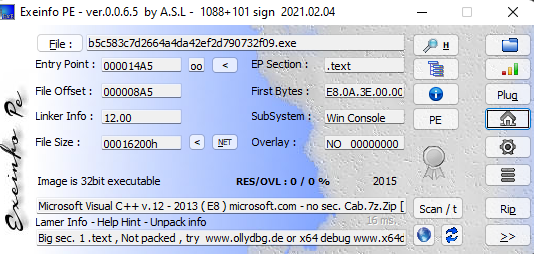
32位的可执行程序,程序没有壳,丢进IDA pro进行静态分析
int __cdecl main(int argc, const char **argv, const char **envp)
{
int v3; // eax
__m128i v5; // [esp+0h] [ebp-44h] BYREF
char v6[8]; // [esp+10h] [ebp-34h] BYREF
int v7; // [esp+18h] [ebp-2Ch]
__int16 v8; // [esp+1Ch] [ebp-28h]
char v9[32]; // [esp+20h] [ebp-24h] BYREF
v5 = _mm_loadu_si128((const __m128i *)"DUTCTF{We1c0met0DUTCTF}");
v7 = 0;
strcpy(v6, "DUTCTF}");
v8 = 0;
printf("欢迎来到DUTCTF呦\n");
printf("这是一道很可爱很简单的逆向题呦\n");
printf("输入flag吧:");
scanf("%s", v9);
v3 = strcmp(v5.m128i_i8, v9);
if ( v3 )
v3 = v3 < 0 ? -1 : 1;
if ( v3 )
printf(aFlag_0);
else
printf(aFlagGet);
system("pause");
return 0;
}
首先,我们需要知道具体的逻辑判断形式,逻辑判断是以什么形式进行判断的,找到逻辑判断语句
if ( v3 )
v3 = v3 < 0 ? -1 : 1;
if ( v3 )
printf(aFlag_0);
else
printf(aFlagGet);
v3 数值不为0的情况下会先执行第一个 if 语句,将不正确的v3值进行转换
然后再进行一个if - else 的逻辑语句,判断v3的数值,如果v3的数值是等于0的,那么我们输入的flag就是正确的
那么,v3 是什么东西?
v3 = strcmp(v5.m128i_i8, v9);
是一个比较数值,如果 v5.m128i_i8 与 v9 相等,那么v3 的数值就等于0了,逻辑现在搞通了,下面跟进数据:

这段数据应该就是 v5 的数据了,将数据转换成字符串

成功得到flag:
DUTCTF{We1c0met0DUTCTF}
0x3 game
应该是个游戏,感觉还是挺有意思的
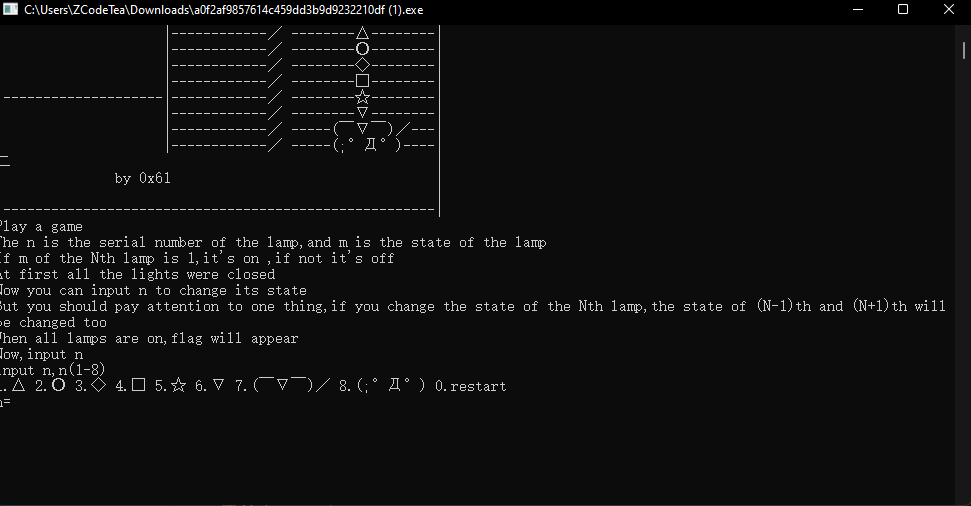
果然是一个游戏,还蛮有意思的,不过,还是要走下流程查一下信息
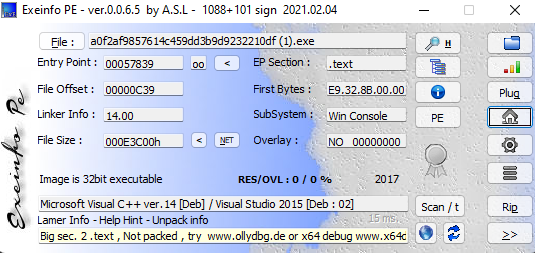
32位程序,没有壳,先丢进IDA pro康一康
int __cdecl main_0(int argc, const char **argv, const char **envp)
{
int i; // [esp+DCh] [ebp-20h]
int v5; // [esp+F4h] [ebp-8h] BYREF
sub_45A7BE(&unk_50B110);
sub_45A7BE(&unk_50B158);
sub_45A7BE(&unk_50B1A0);
sub_45A7BE(&unk_50B1E8);
sub_45A7BE(&unk_50B230);
sub_45A7BE(&unk_50B278);
sub_45A7BE(&unk_50B2C0);
sub_45A7BE(&unk_50B308);
sub_45A7BE("二 |\n");
sub_45A7BE("| by 0x61 |\n");
sub_45A7BE("| |\n");
sub_45A7BE("|------------------------------------------------------|\n");
sub_45A7BE(
"Play a game\n"
"The n is the serial number of the lamp,and m is the state of the lamp\n"
"If m of the Nth lamp is 1,it's on ,if not it's off\n"
"At first all the lights were closed\n");
sub_45A7BE("Now you can input n to change its state\n");
sub_45A7BE(
"But you should pay attention to one thing,if you change the state of the Nth lamp,the state of (N-1)th and (N+1)th w"
"ill be changed too\n");
sub_45A7BE("When all lamps are on,flag will appear\n");
sub_45A7BE("Now,input n \n");
while ( 1 )
{
while ( 1 )
{
sub_45A7BE("input n,n(1-8)\n");
sub_459418();
sub_45A7BE("n=");
sub_4596D4("%d", &v5);
sub_45A7BE("\n");
if ( v5 >= 0 && v5 <= 8 )
break;
sub_45A7BE("sorry,n error,try again\n");
}
if ( v5 )
{
sub_4576D6(v5 - 1);
}
else
{
for ( i = 0; i < 8; ++i )
{
if ( (unsigned int)i >= 9 )
sub_458919();
byte_532E28[i] = 0;
}
}
sub_4581B7("CLS");
sub_458054();
if ( byte_532E28[0] == 1
&& byte_532E28[1] == 1
&& byte_532E28[2] == 1
&& byte_532E28[3] == 1
&& byte_532E28[4] == 1
&& byte_532E28[5] == 1
&& byte_532E28[6] == 1
&& byte_532E28[7] == 1 )
{
sub_457AB4();
}
}
}
寻找到核心代码:
if ( byte_532E28[0] == 1
&& byte_532E28[1] == 1
&& byte_532E28[2] == 1
&& byte_532E28[3] == 1
&& byte_532E28[4] == 1
&& byte_532E28[5] == 1
&& byte_532E28[6] == 1
&& byte_532E28[7] == 1 )
{
sub_457AB4();
}
可以知道,可以确定是 sub_457AB4(); 函数:
int sub_45E940()
{
char v1; // [esp+0h] [ebp-164h]
int i; // [esp+D0h] [ebp-94h]
char v3[22]; // [esp+DCh] [ebp-88h] BYREF
char v4[32]; // [esp+F2h] [ebp-72h] BYREF
char v5[4]; // [esp+112h] [ebp-52h] BYREF
char v6[64]; // [esp+120h] [ebp-44h]
sub_45A7BE((int)"done!!! the flag is ", v1);
v6[0] = 18;
v6[1] = 64;
v6[2] = 98;
v6[3] = 5;
v6[4] = 2;
v6[5] = 4;
v6[6] = 6;
v6[7] = 3;
v6[8] = 6;
v6[9] = 48;
v6[10] = 49;
v6[11] = 65;
v6[12] = 32;
v6[13] = 12;
v6[14] = 48;
v6[15] = 65;
v6[16] = 31;
v6[17] = 78;
v6[18] = 62;
v6[19] = 32;
v6[20] = 49;
v6[21] = 32;
v6[22] = 1;
v6[23] = 57;
v6[24] = 96;
v6[25] = 3;
v6[26] = 21;
v6[27] = 9;
v6[28] = 4;
v6[29] = 62;
v6[30] = 3;
v6[31] = 5;
v6[32] = 4;
v6[33] = 1;
v6[34] = 2;
v6[35] = 3;
v6[36] = 44;
v6[37] = 65;
v6[38] = 78;
v6[39] = 32;
v6[40] = 16;
v6[41] = 97;
v6[42] = 54;
v6[43] = 16;
v6[44] = 44;
v6[45] = 52;
v6[46] = 32;
v6[47] = 64;
v6[48] = 89;
v6[49] = 45;
v6[50] = 32;
v6[51] = 65;
v6[52] = 15;
v6[53] = 34;
v6[54] = 18;
v6[55] = 16;
v6[56] = 0;
v3[0] = 123;
v3[1] = 32;
v3[2] = 18;
v3[3] = 98;
v3[4] = 119;
v3[5] = 108;
v3[6] = 65;
v3[7] = 41;
v3[8] = 124;
v3[9] = 80;
v3[10] = 125;
v3[11] = 38;
v3[12] = 124;
v3[13] = 111;
v3[14] = 74;
v3[15] = 49;
v3[16] = 83;
v3[17] = 108;
v3[18] = 94;
v3[19] = 108;
v3[20] = 84;
v3[21] = 6;
qmemcpy(v4, "`S,yhn _uec{", 12);
v4[12] = 127;
v4[13] = 119;
v4[14] = 96;
v4[15] = 48;
v4[16] = 107;
v4[17] = 71;
v4[18] = 92;
v4[19] = 29;
v4[20] = 81;
v4[21] = 107;
v4[22] = 90;
v4[23] = 85;
v4[24] = 64;
v4[25] = 12;
v4[26] = 43;
v4[27] = 76;
v4[28] = 86;
v4[29] = 13;
v4[30] = 114;
v4[31] = 1;
strcpy(v5, "u~");
for ( i = 0; i < 56; ++i )
{
v3[i] ^= v6[i];
v3[i] ^= 0x13u;
}
return sub_45A7BE((int)"%s\n", (char)v3);
}
基本上可以确定在这里输出flag,基本逻辑应该可以清晰的知道
下面使用Ollydbg进行动态调试,调试出来flag
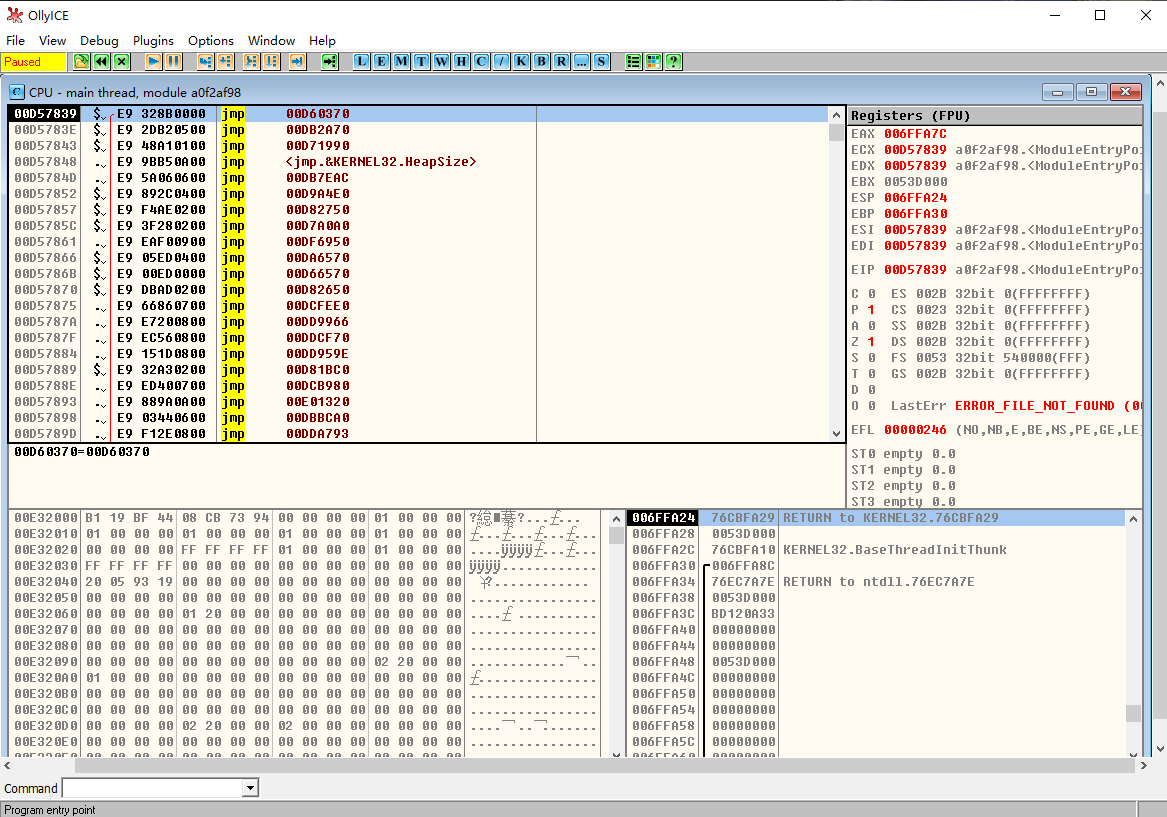
先使用F8进行单步调试,确定关键函数位置
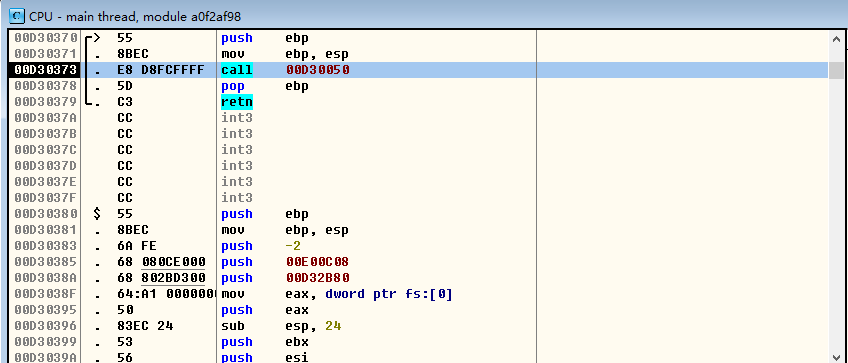
F7进入函数的具体执行过程,进行字符串检索

找到输入的关键位置,然后移动到关键位置

根据已知的逻辑循环,修改逻辑循环
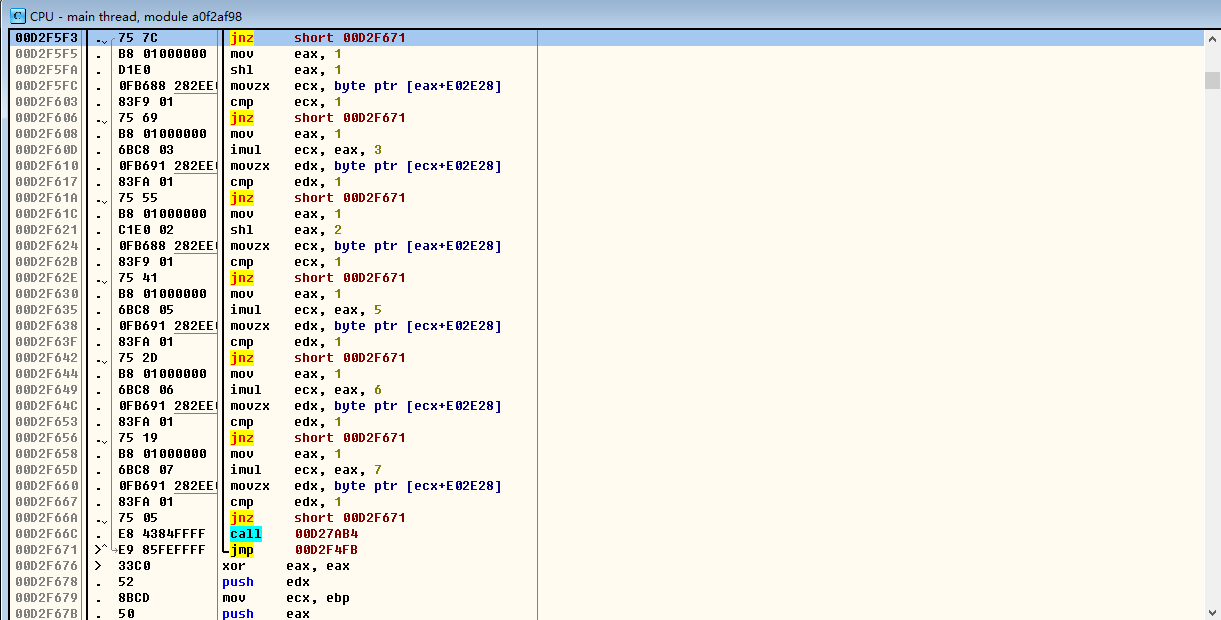
修改这个关键性的跳转代码进行跳转修改,将跳转修改为call那个位置
修改为:
jnz short 00D2F66C
然后运行修改过汇编的程序
尝试输入几个参数就能获取到flag了
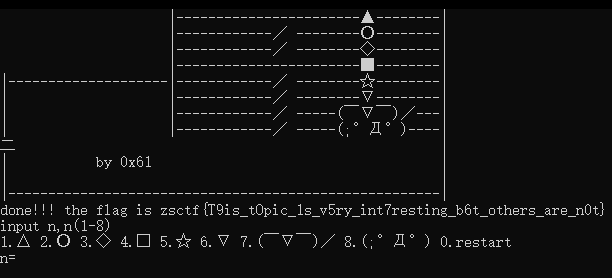
得到flag
zsctf{T9is_tOpic_1s_v5ry_int7resting_b6t_others_are_n0t}
0x4 Hello, CTF
首先查一下程序信息
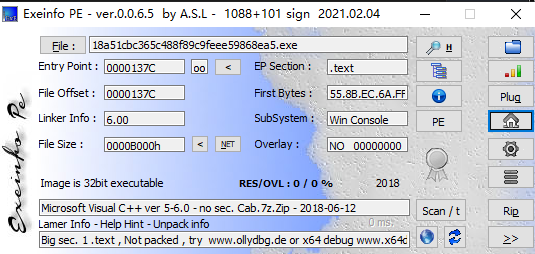
32位没有壳的程序
使用IDA pro的看一下程序
int __cdecl main(int argc, const char **argv, const char **envp)
{
int i; // ebx
char v4; // al
int result; // eax
int v6; // [esp+0h] [ebp-70h]
int v7; // [esp+0h] [ebp-70h]
char Buffer[2]; // [esp+12h] [ebp-5Eh] BYREF
char v9[20]; // [esp+14h] [ebp-5Ch] BYREF
char v10[32]; // [esp+28h] [ebp-48h] BYREF
__int16 v11; // [esp+48h] [ebp-28h]
char v12; // [esp+4Ah] [ebp-26h]
char v13[36]; // [esp+4Ch] [ebp-24h] BYREF
strcpy(v13, "437261636b4d654a757374466f7246756e");
while ( 1 )
{
memset(v10, 0, sizeof(v10));
v11 = 0;
v12 = 0;
sub_40134B(aPleaseInputYou, v6);
scanf("%s", v9);
if ( strlen(v9) > 0x11 )
break;
for ( i = 0; i < 17; ++i )
{
v4 = v9[i];
if ( !v4 )
break;
sprintf(Buffer, "%x", v4);
strcat(v10, Buffer);
}
if ( !strcmp(v10, v13) )
sub_40134B(aSuccess, v7);
else
sub_40134B(aWrong, v7);
}
sub_40134B(aWrong, v7);
result = --Stream._cnt;
if ( Stream._cnt < 0 )
return _filbuf(&Stream);
++Stream._ptr;
return result;
}
代码非常清晰,应该可以明确v13的值和flag应该是一致的
v13应该是Hex编码的字符串,进行解码就得到flag了
CrackMeJustForFun
0x5 open-source
下载附件,源代码审计,看看源代码内容
#include <stdio.h>
#include <string.h>
int main(int argc, char *argv[]) {
if (argc != 4) {
printf("what?\n");
exit(1);
}
unsigned int first = atoi(argv[1]);
if (first != 0xcafe) {
printf("you are wrong, sorry.\n");
exit(2);
}
unsigned int second = atoi(argv[2]);
if (second % 5 == 3 || second % 17 != 8) {
printf("ha, you won't get it!\n");
exit(3);
}
if (strcmp("h4cky0u", argv[3])) {
printf("so close, dude!\n");
exit(4);
}
printf("Brr wrrr grr\n");
unsigned int hash = first * 31337 + (second % 17) * 11 + strlen(argv[3]) - 1615810207;
printf("Get your key: ");
printf("%x\n", hash);
return 0;
}
根据源码进行求解,其实也就是解个方程
可以写个C程序直接求解
#include <stdio.h>
#include <string.h>
int main() {
unsigned int first = 0xcafe;
unsigned int second = 25;
char * Third = "h4cky0u";
unsigned int hash = first * 31337 + (second % 17) * 11 + strlen(Third) - 1615810207;
printf("Get your key: ");
printf("%x\n", hash);
return 0;
}
编译并运行程序就能得到flag:
Get your key: c0ffee
0x6 simple-unpack
看题目,应该是一个有壳的程序
就正常走一下流程首先先要看看程序的信息
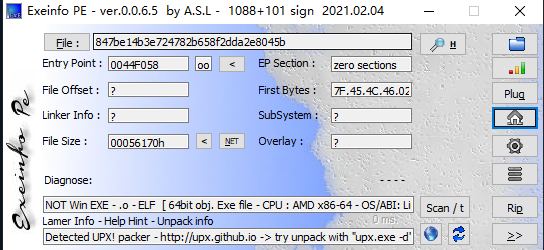
加壳的64位的程序,首先使用upx脱一下壳,然后使用x64 IDA pro查看
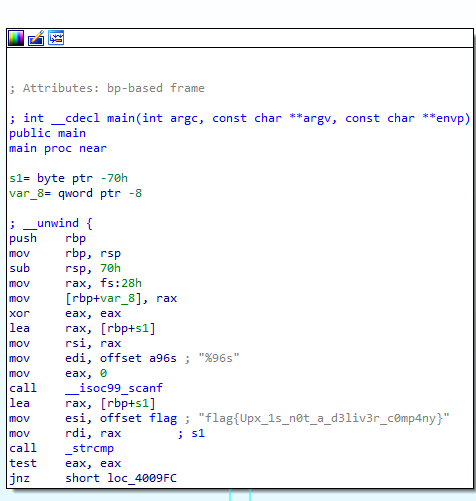
直接就能看到flag信息数据
flag{Upx_1s_n0t_a_d3liv3r_c0mp4ny}
0x7 logmein
查一下程序信息
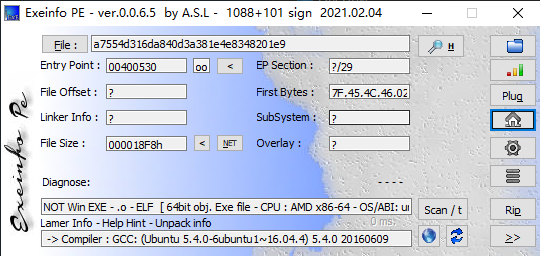
没有壳,64位的Linux程序
直接进行x64 ida pro静态调试
void __fastcall __noreturn main(int a1, char **a2, char **a3)
{
size_t v3; // rsi
int i; // [rsp+3Ch] [rbp-54h]
char s[36]; // [rsp+40h] [rbp-50h] BYREF
int v6; // [rsp+64h] [rbp-2Ch]
__int64 v7; // [rsp+68h] [rbp-28h]
char v8[28]; // [rsp+70h] [rbp-20h] BYREF
int v9; // [rsp+8Ch] [rbp-4h]
v9 = 0;
strcpy(v8, ":\"AL_RT^L*.?+6/46");
v7 = 0x65626D61726168LL;
v6 = 7;
printf("Welcome to the RC3 secure password guesser.\n");
printf("To continue, you must enter the correct password.\n");
printf("Enter your guess: ");
__isoc99_scanf("%32s", s);
v3 = strlen(s);
if ( v3 < strlen(v8) )
sub_4007C0();
for ( i = 0; i < strlen(s); ++i )
{
if ( i >= strlen(v8) )
sub_4007C0();
if ( s[i] != (char)(*((_BYTE *)&v7 + i % v6) ^ v8[i]) )
sub_4007C0();
}
sub_4007F0();
}
应该是对算法进行逆向来得到相应的flag
关键的数据是v7和v8,针对这两个数据写个C程序进行逆向算法
#include <stdio.h>
#include <string.h>
int main()
{
char v8[28];
strcpy(v8, ":\"AL_RT^L*.?+6/46");
char *v7 = "harambe";
int v6 = 7;
char s[strlen(v8)];
for (int i = 0; i < strlen(v8); ++i )
{
s[i] = *(v7+i % v6) ^ v8[i];
}
printf("%s\n",s);
}
编译并运行得到flag
RC3-2016-XORISGUD
0x8 no-string-attached
查一下文件的信息
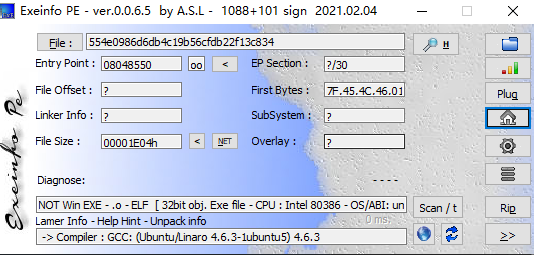
32位文件,没有壳,丢进到IDA pro查看
int __cdecl main(int argc, const char **argv, const char **envp)
{
setlocale(6, &locale);
banner();
prompt_authentication();
authenticate();
return 0;
}
进行分析,确定flag应该是在 authenticate()函数中
跟进到 authenticate()函数
void authenticate()
{
wchar_t ws[8192]; // [esp+1Ch] [ebp-800Ch] BYREF
wchar_t *s2; // [esp+801Ch] [ebp-Ch]
s2 = (wchar_t *)decrypt((wchar_t *)&s, (wchar_t *)&dword_8048A90);
if ( fgetws(ws, 0x2000, stdin) )
{
ws[wcslen(ws) - 1] = 0;
if ( !wcscmp(ws, s2) )
wprintf(&unk_8048B44);
else
wprintf(&unk_8048BA4);
}
free(s2);
}
关键数据应该是在s2中,调用了decrypt函数,看一下这个函数的汇编代码
ws= dword ptr -800Ch
s2= dword ptr -0Ch
; __unwind {
push ebp
mov ebp, esp
sub esp, 8028h
mov dword ptr [esp+4], offset dword_8048A90 ; wchar_t *
mov dword ptr [esp], offset s ; s
call decrypt
mov [ebp+s2], eax
mov eax, ds:stdin@@GLIBC_2_0
mov [esp+8], eax ; stream
mov dword ptr [esp+4], 2000h ; n
lea eax, [ebp+ws]
mov [esp], eax ; ws
call _fgetws
test eax, eax
jz short loc_804879C
根据汇编代码,应该可以清晰的知道,flag数据应该是存储在eax寄存器中了
使用gdb动态调试程序
gdb Re_demo
然后设置断点,根据刚刚了解到的信息,flag的数据应该是在decrypt函数中,设置断点
b decrypt
然后运行程序到断点
r
然后单步执行
n
查看寄存器
i r
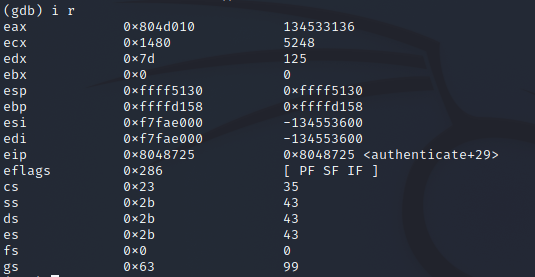
然后查看eax寄存器存储的数据
x/sw $eax

成功拿到flag数据
9447{you_are_an_international_mystery}
0x9 getit
基本流程,查看程序信息
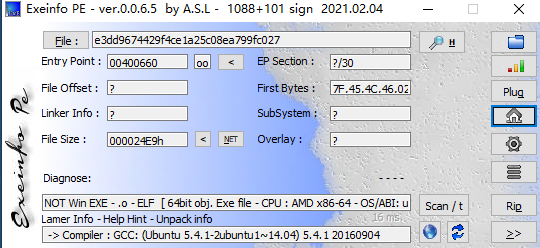
64位无壳的ELF可执行程序
先丢进x64 IDA pro看一看
int __cdecl main(int argc, const char **argv, const char **envp)
{
char v3; // al
int i; // [rsp+0h] [rbp-40h]
int j; // [rsp+4h] [rbp-3Ch]
FILE *stream; // [rsp+8h] [rbp-38h]
char filename[24]; // [rsp+10h] [rbp-30h] BYREF
unsigned __int64 v9; // [rsp+28h] [rbp-18h]
v9 = __readfsqword(0x28u);
for ( i = 0; i < strlen(s); ++i )
{
if ( (i & 1) != 0 )
v3 = 1;
else
v3 = -1;
*(&t + i + 10) = s[i] + v3;
}
strcpy(filename, "/tmp/flag.txt");
stream = fopen(filename, "w");
fprintf(stream, "%s\n", u);
for ( j = 0; j < strlen(&t); ++j )
{
fseek(stream, p[j], 0);
fputc(*(&t + p[j]), stream);
fseek(stream, 0LL, 0);
fprintf(stream, "%s\n", u);
}
fclose(stream);
remove(filename);
return 0;
}
应该是一个文件写入的程序,打开一个文件并进行写入
对程序进行分析应该可以看出三个部分
- 初始化变量
- 生成flag数据
- 写入flag数据
查看一下静态数据:

根据静态数据和对代码分析的结果,写一个flag生成器:
#include <stdio.h>
#include <string.h>
int main()
{
char t[] =" harifCTF{????????????????????????????????}";
char s[] = "c61b68366edeb7bdce3c6820314b7498";
t[0] = 0x53;
int i, v3;
for ( i = 0; i < strlen(s); ++i )
{
if ( (i & 1) != 0 )
v3 = 1;
else
v3 = -1;
*(t+i+10) = s[i]+v3;
}
printf("%s\n",t);
return 0;
}
编译并运行flag生成器就可以生成flag啦!
SharifCTF{b70c59275fcfa8aebf2d5911223c6589}
0xA csaw2013reversing2
杀软会报毒的程序,首先查一下壳
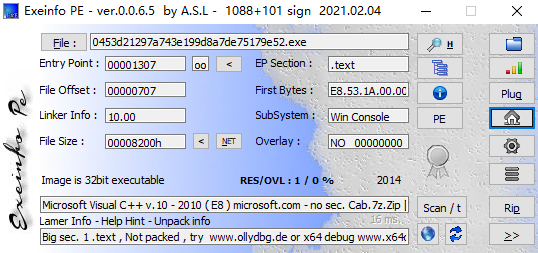
32位无壳程序,使用IDA pro查看详细信息
int __cdecl __noreturn main(int argc, const char **argv, const char **envp)
{
int v3; // ecx
CHAR *lpMem; // [esp+8h] [ebp-Ch]
HANDLE hHeap; // [esp+10h] [ebp-4h]
hHeap = HeapCreate(0x40000u, 0, 0);
lpMem = (CHAR *)HeapAlloc(hHeap, 8u, SourceSize + 1);
memcpy_s(lpMem, SourceSize, &unk_409B10, SourceSize);
if ( !sub_40102A() && !IsDebuggerPresent() )
{
MessageBoxA(0, lpMem + 1, "Flag", 2u);
HeapFree(hHeap, 0, lpMem);
HeapDestroy(hHeap);
ExitProcess(0);
}
__debugbreak();
sub_401000(v3 + 4, lpMem);
ExitProcess(0xFFFFFFFF);
}
都是WIN32api的调用,尝试运行一下程序:
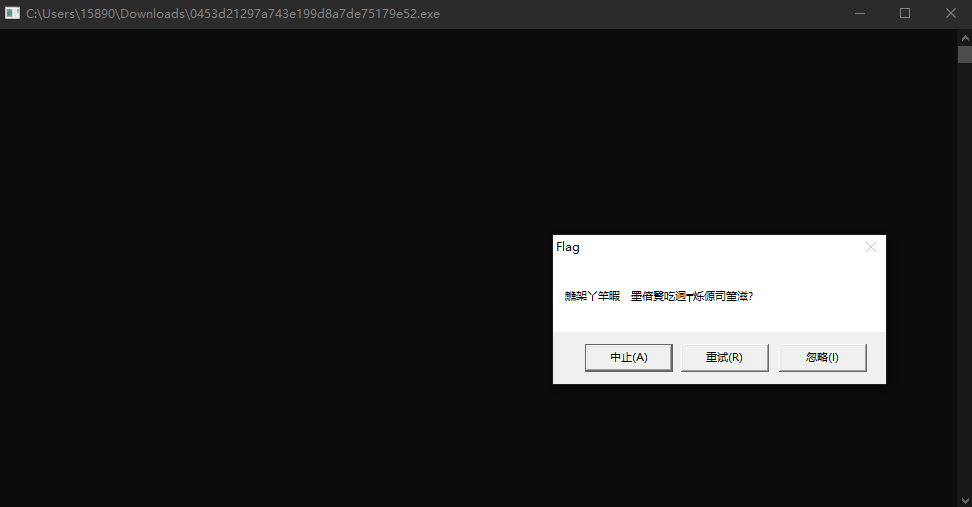
应该是有些关键的语句没有执行
可以查看下IDA pro的汇编语句
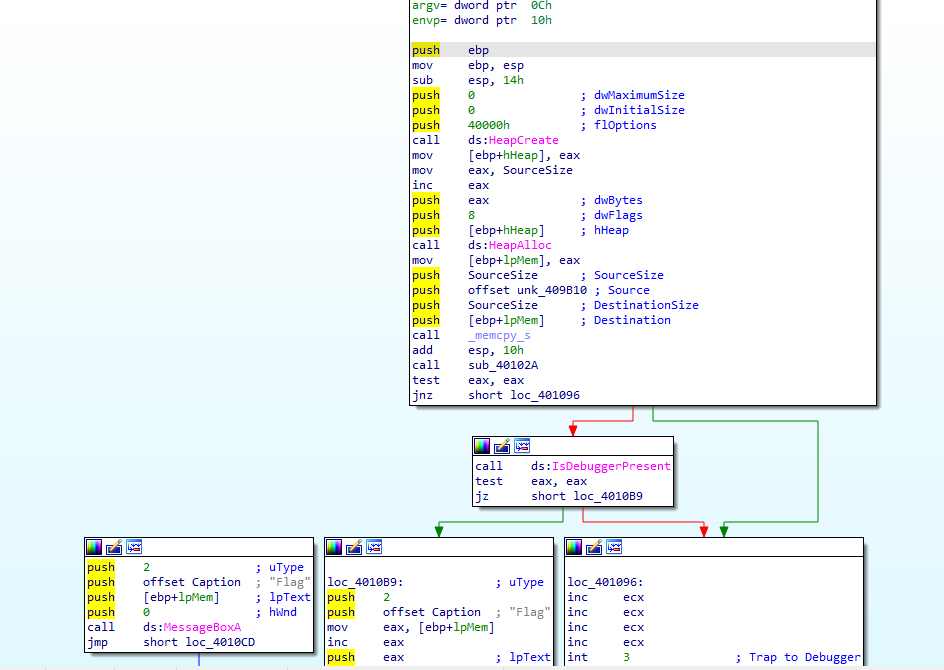
显然是有一个Flag没有进行相应的跳转,显然有着较大的嫌疑,可以尝试去搞一搞让其跳转
使用OD进行调试修改汇编让其进行跳转,首先定位到Flag
000D1092 . 85C0 test eax, eax
000D1094 74 23 je short 000D10B9
000D1096 > 41 inc ecx
000D1097 . 41 inc ecx
000D1098 . 41 inc ecx
000D1099 . 41 inc ecx
000D109A CC int3
000D109B . 8B55 F4 mov edx, dword ptr [ebp-C]
000D109E . E8 5DFFFFFF call 000D1000
000D10A3 EB 4A jmp short 000D10EF
000D10A5 . 6A 02 push 2 ; /Style = MB_ABORTRETRYIGNORE|MB_APPLMODAL
000D10A7 . 68 20780D00 push 000D7820 ; |Title = "Flag"
000D10AC . FF75 F4 push dword ptr [ebp-C] ; |Text
000D10AF . 6A 00 push 0 ; |hOwner = NULL
000D10B1 . FF15 E4600D00 call dword ptr [<&USER32.MessageBoxA>>; \MessageBoxA
000D10B7 . EB 14 jmp short 000D10CD
000D10B9 > 6A 02 push 2 ; /Style = MB_ABORTRETRYIGNORE|MB_APPLMODAL
000D10BB . 68 20780D00 push 000D7820 ; |Title = "Flag"
000D10C0 . 8B45 F4 mov eax, dword ptr [ebp-C] ; |
000D10C3 . 40 inc eax ; |
000D10C4 . 50 push eax ; |Text
000D10C5 . 6A 00 push 0 ; |hOwner = NULL
000D10C7 . FF15 E4600D00 call dword ptr [<&USER32.MessageBoxA>>; \MessageBoxA
然后定位到if语句对应的汇编语句
000D1083 . E8 A2FFFFFF call 000D102A
000D1088 . 85C0 test eax, eax
000D108A . 75 0A jnz short 000D1096
000D108C . FF15 14600D00 call dword ptr [<&KERNEL32.IsDebugger>; [IsDebuggerPresent
000D1092 . 85C0 test eax, eax
000D1094 74 23 je short 000D10B9
000D1096 > 41 inc ecx
000D1097 . 41 inc ecx
000D1098 . 41 inc ecx
000D1099 . 41 inc ecx
000D109A CC int3
000D109B . 8B55 F4 mov edx, dword ptr [ebp-C]
000D109E . E8 5DFFFFFF call 000D1000
000D10A3 EB 4A jmp short 000D10EF
关键就是对这些汇编语句进行修改来获得flag数据,运行过程中有一个int3断点应该是让程序进行终止的,然后就是je跳转语句和jmp跳转语句了。对je跳转语句进行修改和jmp跳转语句进行修改,设置断点进行调试应该就可以获得flag
修改过的汇编语句
000D1083 . E8 A2FFFFFF call 000D102A
000D1088 . 85C0 test eax, eax
000D108A . 75 0A jnz short 000D1096
000D108C . FF15 14600D00 call dword ptr [<&KERNEL32.IsDebugger>; [IsDebuggerPresent
000D1092 . 85C0 test eax, eax
000D1094 90 nop
000D1095 90 nop
000D1096 > 41 inc ecx
000D1097 . 41 inc ecx
000D1098 . 41 inc ecx
000D1099 . 41 inc ecx
000D109A 90 nop
000D109B . 8B55 F4 mov edx, dword ptr [ebp-C]
000D109E . E8 5DFFFFFF call 000D1000
000D10A3 EB 14 jmp short 000D10B9
然后设置断点进行调试,来获得flag
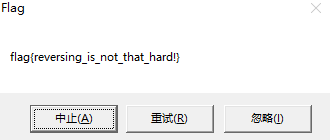
成功得到flag
flag{reversing_is_not_that_hard!}
0xB maze
走迷宫的题目,逆向题目中多少有些趣味的题目,来一起走迷宫吧
首先查看一下程序信息
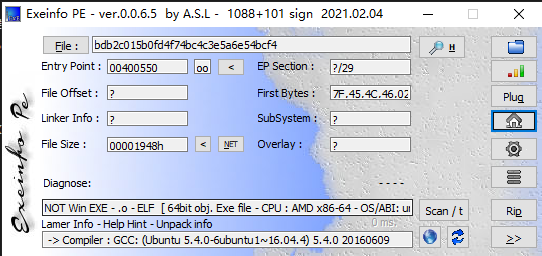
64位的程序,使用x64 IDA pro查看一下
__int64 __fastcall main(int a1, char **a2, char **a3)
{
__int64 v3; // rbx
int v4; // eax
char v5; // bp
char v6; // al
const char *v7; // rdi
unsigned int v9; // [rsp+0h] [rbp-28h] BYREF
int v10[9]; // [rsp+4h] [rbp-24h] BYREF
v10[0] = 0;
v9 = 0;
puts("Input flag:");
scanf("%s", &s1);
if ( strlen(&s1) != 24 || strncmp(&s1, "nctf{", 5uLL) || *(&byte_6010BF + 24) != 125 )
{
LABEL_22:
puts("Wrong flag!");
exit(-1);
}
v3 = 5LL;
if ( strlen(&s1) - 1 > 5 )
{
while ( 1 )
{
v4 = *(&s1 + v3);
v5 = 0;
if ( v4 > 78 )
{
if ( (unsigned __int8)v4 == 79 )
{
v6 = sub_400650(v10);
goto LABEL_14;
}
if ( (unsigned __int8)v4 == 111 )
{
v6 = sub_400660(v10);
goto LABEL_14;
}
}
else
{
if ( (unsigned __int8)v4 == 46 )
{
v6 = sub_400670(&v9);
goto LABEL_14;
}
if ( (unsigned __int8)v4 == 48 )
{
v6 = sub_400680(&v9);
LABEL_14:
v5 = v6;
goto LABEL_15;
}
}
LABEL_15:
if ( !(unsigned __int8)sub_400690(asc_601060, (unsigned int)v10[0], v9) )
goto LABEL_22;
if ( ++v3 >= strlen(&s1) - 1 )
{
if ( v5 )
break;
LABEL_20:
v7 = "Wrong flag!";
goto LABEL_21;
}
}
}
if ( asc_601060[8 * v9 + v10[0]] != 35 )
goto LABEL_20;
v7 = "Congratulations!";
LABEL_21:
puts(v7);
return 0LL;
}
函数的主要逻辑应该是根据输入的值来进行走迷宫的,走出迷宫即得到flag。程序中肯定存在的有迷宫的地图作为静态数据存储。所以可以尝试查看静态数据:
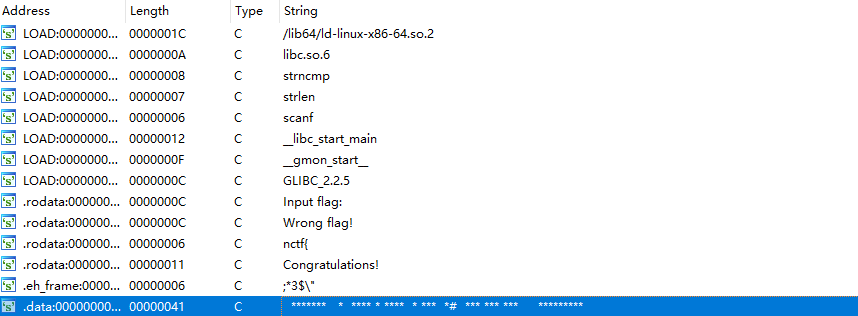
果然有一个类似迷宫的数据,查看迷宫数据
******* * **** * **** * *** *# *** *** *** *********
需要对代码进行分析来进一步得到迷宫的大致样子
if ( strlen(&s1) != 24 || strncmp(&s1, "nctf{", 5uLL) || *(&byte_6010BF + 24) != 125 )
{
LABEL_22:
puts("Wrong flag!");
exit(-1);
}
根据这段代码可以判断出走出迷宫需要18个操作数
while ( 1 )
{
v4 = *(&s1 + v3);
v5 = 0;
if ( v4 > 78 )
{
if ( (unsigned __int8)v4 == 'O' )
{
v6 = sub_400650(v10);
goto LABEL_14;
}
if ( (unsigned __int8)v4 == 'o' )
{
v6 = sub_400660(v10);
goto LABEL_14;
}
}
else
{
if ( (unsigned __int8)v4 == '.' )
{
v6 = sub_400670(&v9);
goto LABEL_14;
}
if ( (unsigned __int8)v4 == '0' )
{
v6 = sub_400680(&v9);
这些是对迷宫操作的判断,根据这些判断可以确定我们如何进行迷宫的操作
首先根据反汇编的代码进行分析,可以发现有两个关键数据有着比较重要的作用就是v10就v9的数据,根据跟进分析,发现v10 是进行横向操作,发现v9 是纵向操作。然后根据函数内部的加或减来确定 上下左右 的方向。
对代码进行进一步分析应该就知道对应操作:
'O' ←
'o' →
'.' ↑
'0' ↓
根据代码的分析,迷宫应该是8x8的迷宫,可以排列出迷宫的样子
00******
*000*00*
***0*0**
**00*0**
*00*#00*
**0***0*
**00000*
********
根据目前的分析的结果就可以开心地走迷宫了:
o0oo00O000oooo..OO
迷宫路线即为flag,因此本题的flag为:
nctf{o0oo00O000oooo..OO}